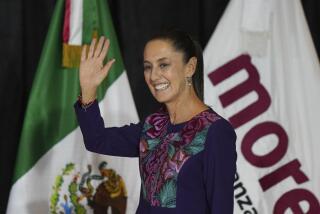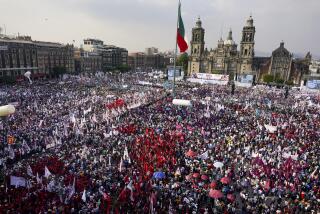Mexico’s Banks Are Again in Crisis : Economy: High bad-loan ratio casts new doubt on contentions that the country has begun to overcome its problems.
MEXICO CITY ‚ÄĒ A rash of bad news is again plaguing Mexico‚Äôs banks, casting fresh doubt on claims by Mexican and U.S. political leaders that Mexico has begun to recover from its yearlong economic crisis.
Fresh disclosures to the World Bank show that the percentage of Mexico’s bank loans on which customers have quit paying reached 17.7% in October, the highest ratio since the government nationalized the industry in 1982.
The bad-loan ratio, already considerably understated by U.S. standards, is certain to jump higher once Mexican borrowers feel the full effects of the sharp rise in interest rates of the past several weeks.
Meanwhile, the government late last week took over Mexico’s fourth-largest bank, the parent of 319-branch Banco Inverlat, the sixth and largest institution seized since the peso devaluation last December plunged the country into crisis.
Mexico had been trying to arrange a sale of troubled Banco Inverlat to Canada’s Bank of Nova Scotia, which already had an 8% stake. But ScotiaBank Vice Chairman Robert Chisholm said on Friday that the recent rise in interest rates and Mexico’s worse-than-expected economic performance forced his company to back away from a possible purchase.
Last week, the Canadian bank wrote off 90% of the value of its Inverlat investment, he said.
‚ÄúThe severe rise in interest rates and inflation has had a severe impact and created more stress for Inverlat customers who were already having a heck of a time paying interest on their loans,‚ÄĚ Chisholm said.
‚ÄúInverlat is not atypical,‚ÄĚ he said. Mexico ‚Äúhas a systemic, broad-based problem.‚ÄĚ
Mexico’s banking commission said that it will disclose today the cost of the Inverlat takeover.
The nation’s bad loan ratio compares to U.S. banks’ problem portfolio of 11% of total loans during the depths of the 1983 banking crisis, when developing countries stopped paying loans from major U.S. banks. Only U.S. government intervention saved several major banks from going under.
Bad loans of Japan’s banks, which are also in crisis, are now estimated at about 10% of the total.
The Inverlat failure and rise in problem loans put Mexico’s financial system under increased pressure and boost the ultimate cost of the banking system’s bailout, part of which is being shouldered by the United States and other international lenders.
Previously, the bailout cost was pegged at about $11 billion, with about a third coming from foreign sources.
The higher percentage of bad loans ultimately means that banks will shift more problem assets to Mexico’s Deposit Protection Banking Fund, similar to the U.S. Federal Deposit Insurance Corp., which is designed to shield depositors from losses.
Indeed, earlier last week Mexico’s two largest banks--Banamex and Bancomer--confirmed that they are in discussions to transfer a combined $3 billion in bad loans to the government agency.
Although the bad loans handed off to the government are taken off the troubled bank’s balance sheet, the institution is still responsible for collection and has a profit incentive to return the loan to current status.
The portfolio of bad loans has risen steadily since last December, when it stood at 9%. Total loans in Mexico’s banking system are about $100 billion.
Yet the latest figures do not fully reflect the damage done by a recent surge in interest rates--to a current 53% on one-month treasury bills from 32% in mid-September--which will make it even harder for borrowers to pay back loans.
‚ÄúThe interest rate jump is particularly bad news for banks because borrowers have a threshold--interest rates of no more than 35% to 40%--beyond which they expect their loans to be restructured, which makes it harder for the banks,‚ÄĚ said Darryl McLeod, senior Latin American economist at Lehman Bros.
Mexico’s bad loan ratio almost certainly would be worse if tougher U.S. auditing standards were applied, experts said.
‚ÄúYou‚Äôve got to look at the entire picture and be candid about it, which Mexican bankers typically aren‚Äôt among themselves, much less among outsiders,‚ÄĚ said Bert Ely, an Alexandria, Va.-based banking consultant.
The problem-loan report is the latest monthly update filed by Mexican banks with the World Bank and the Inter-American Development Bank as a condition of the Mexican rescue package approved earlier this year.
(BEGIN TEXT OF INFOBOX / INFOGRAPHIC)
Problem Loans
Mexico’s banking crisis has steadily worsened after the devaluation of the peso in December, 1994, and the proportion of outstanding loans deemed uncollectible reached a new high in October. Percentage of bad loans:
Oct. 1995: 17.7%
Note: Mexico provided data quarterly until June, when international lenders demanded monthly reports.
Source: World Bank
More to Read
Sign up for Essential California
The most important California stories and recommendations in your inbox every morning.
You may occasionally receive promotional content from the Los Angeles Times.










